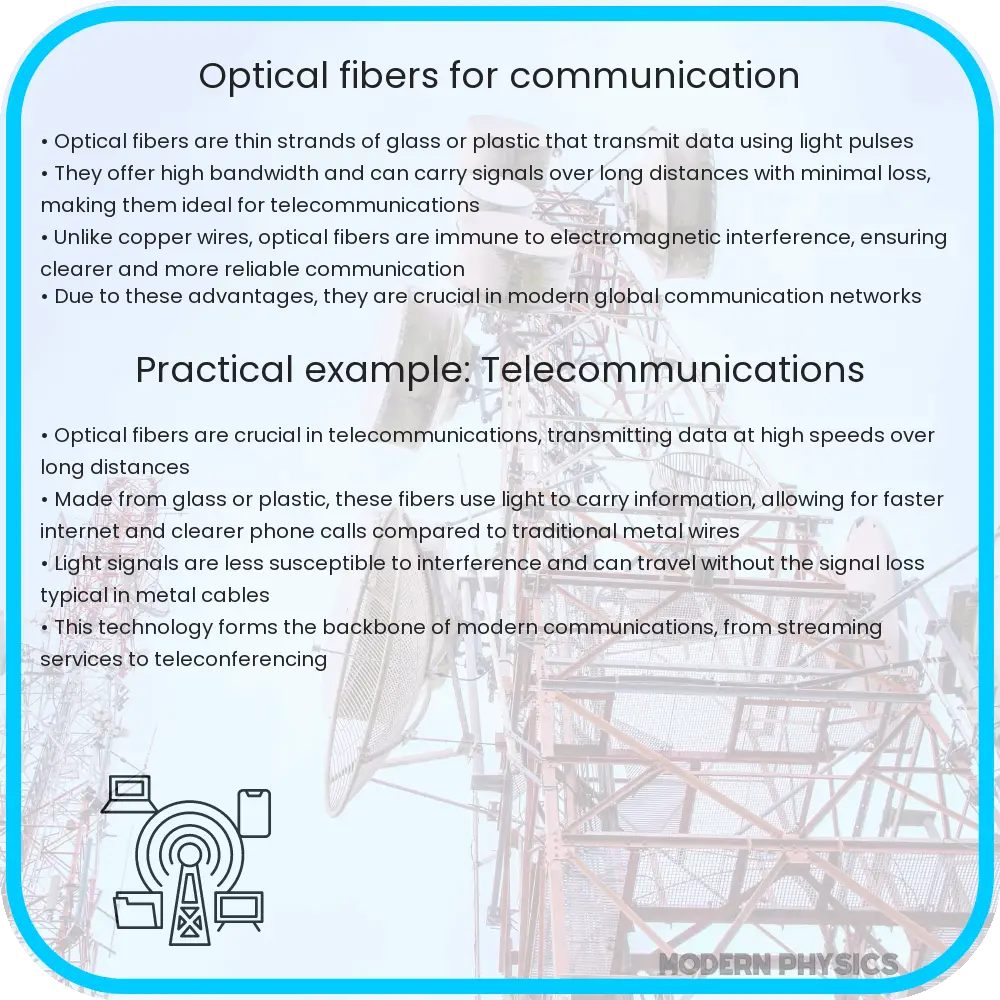Explore how optical fibers revolutionize communication with unmatched speed, efficiency, and clarity, and their role in future technological advancements.

Understanding Optical Fibers in Communication
Optical fibers have revolutionized the way we communicate, offering unparalleled speed, efficiency, and clarity. These thin strands of glass or plastic transmit information as pulses of light, allowing for the rapid transmission of data over long distances with minimal loss. The core principle behind optical fiber technology is total internal reflection, which enables light to be guided along the fiber’s length.
The Speed of Optical Fiber Communication
The speed at which optical fibers transmit data is staggering, often reaching up to hundreds of gigabits per second. This is possible due to the extremely high frequency of light waves used in fiber optics, which allows for a vast amount of information to be carried simultaneously. The use of Dense Wavelength Division Multiplexing (DWDM) further enhances this capacity, enabling multiple light waves of different frequencies to be sent through the same fiber simultaneously, significantly increasing the data transmission rate.
Efficiency and Reliability
Optical fibers are highly efficient, with a much lower attenuation rate compared to traditional copper cables. This means that they can transmit information over very long distances without the need for as many signal boosters or repeaters, reducing energy consumption and maintenance costs. Additionally, optical fibers are immune to electromagnetic interference, which ensures that the data transmitted is not affected by external noise, leading to a more reliable communication channel.
Clarity of Signal
The clarity of the signal transmitted through optical fibers is another significant advantage. Due to the low levels of signal loss and the absence of interference, the integrity of the data is preserved over long distances. This results in clear, high-quality audio and video communication, making optical fibers an ideal medium for broadcasting and telecommunications.
Furthermore, the advent of fiber-optic technology has paved the way for advancements in internet speeds and bandwidth capabilities. It has enabled the development of high-speed internet services, such as fiber to the home (FTTH), which offers consumers lightning-fast download and upload speeds that significantly surpass those available through traditional broadband connections.
Advancements in Optical Fiber Technology
Technological advancements continue to push the boundaries of optical fiber capabilities. Researchers are constantly exploring new materials and designs to further enhance the performance of optical fibers. For instance, the development of photonic crystal fibers (PCFs) offers more control over light propagation, allowing for even higher data transmission rates and the potential for new applications in fields such as medical imaging and sensing technologies.
Environmental Impact and Sustainability
Optical fibers also offer environmental benefits. Their energy efficiency and the ability to transmit data over long distances without significant loss mean a reduced carbon footprint compared to traditional communication methods. Moreover, the durability and longevity of optical fibers reduce the need for frequent replacements, contributing to waste reduction and promoting sustainability in the telecommunications industry.
Challenges and Future Directions
Despite their numerous advantages, optical fiber technologies face challenges. The initial installation and infrastructure costs can be high, especially for underdeveloped regions. Furthermore, optical fibers are delicate and require protection from physical damage. However, ongoing research and development efforts are focused on making optical fiber technology more affordable and robust. Innovations such as flexible glass and improved protective coatings are making fibers more durable and easier to install.
The future of optical fiber communication looks promising, with ongoing research aimed at increasing data transmission rates, improving fiber durability, and reducing costs. The potential for integrating optical fibers with emerging technologies such as quantum computing and the Internet of Things (IoT) opens up exciting possibilities for even faster and more secure communication networks.
Conclusion
Optical fiber technology has become a cornerstone of modern communication, offering unmatched speed, efficiency, and clarity. Its benefits extend beyond just faster internet speeds, contributing to advancements in various fields and promoting environmental sustainability. As we look to the future, the continued evolution of optical fiber technology promises to further transform our digital landscape, making our communication networks more robust, efficient, and capable of meeting the demands of an increasingly connected world.
